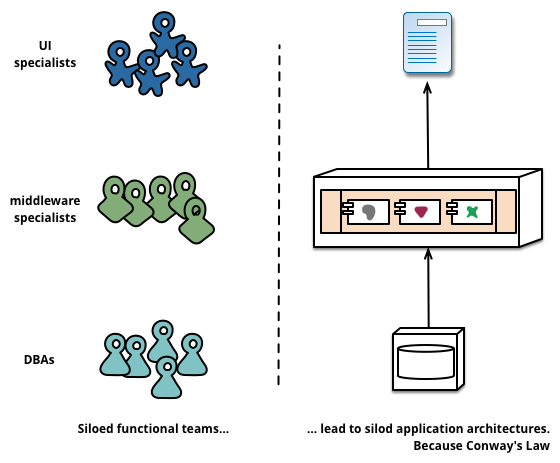
"Micro Services" is a new buzzword in world of IT architects. As it talks about application components communicating over a network and contains "services", it probably has something to do with SOA and integration. So I had to look into it.
Let's bulletize the description from the article by Martin Fowler and James Lewis:
Microservices are an architecture used by very large, modern IT systems such as LinkedIn, Netflix, Amazon and eBay. There's all sorts of interesting aspects to Micro Services, e.g. the GUI part, security, transactional integrity, versioning etc.
Conway law - Integration Competence Center
But there was one aspect that triggered me in particular when learning about Microservices: Conway Law: "any organization that designs a system (defined broadly) will produce a design whose structure is a copy of the organization's communication structure".
So this law states that an application architecture will reflect the way an IT department is organized. Microservices advocates refer a lot to it.
 |
| Service boundaries reinforced by team boundaries (picture from article by Martin Fowler) |
For Microservices to focus and align with business functionality, the teams developing (and maintaining) the Microservices should therefore be cross-functional, including the full range of skills required for the development: user-experience, database, and project management.
Orthogonal to the view of the Microservices architects, that Conway Law confirms my personal view and opinion that any IT organization that wishes to leverage a central integration platform to a great extent, requires a separate team developing on and managing that integration platform.
How did I learn about MicroServices?
 |
|
PS: when searching for the term "micro service", I found the term also in the book "Java Web Services Architecture" back from 2003!


29 en 30 oktober 2025 Deze 2-daagse cursus is ontworpen om dataprofessionals te voorzien van de kennis en praktische vaardigheden die nodig zijn om Knowledge Graphs en Large Language Models (LLM's) te integreren in hun workflows voor datamodel...
3 t/m 5 november 2025Praktische workshop met internationaal gerenommeerde spreker Alec Sharp over het modelleren met Entity-Relationship vanuit business perspectief. De workshop wordt ondersteund met praktijkvoorbeelden en duidelijke, herbruikbare ri...
17 t/m 19 november 2025 De DAMA DMBoK2 beschrijft 11 disciplines van Data Management, waarbij Data Governance centraal staat. De Certified Data Management Professional (CDMP) certificatie biedt een traject voor het inleidende niveau (Associate) tot...
25 en 26 november 2025 Worstelt u met de implementatie van data governance of de afstemming tussen teams? Deze baanbrekende workshop introduceert de Data Governance Sprint - een efficiënte, gestructureerde aanpak om uw initiatieven op het...
26 november 2025 Workshop met BPM-specialist Christian Gijsels over AI-Gedreven Business Analyse met ChatGPT. Kunstmatige Intelligentie, ongetwijfeld een van de meest baanbrekende technologieën tot nu toe, opent nieuwe deuren voor analisten met ...
8 t/m 10 juni 2026Praktische driedaagse workshop met internationaal gerenommeerde spreker Alec Sharp over herkennen, beschrijven en ontwerpen van business processen. De workshop wordt ondersteund met praktijkvoorbeelden en duidelijke, herbruikbare ri...
Alleen als In-house beschikbaarWorkshop met BPM-specialist Christian Gijsels over business analyse, modelleren en simuleren met de nieuwste release van Sparx Systems' Enterprise Architect, versie 16.Intensieve cursus waarin de belangrijkste basisfunc...
Deel dit bericht